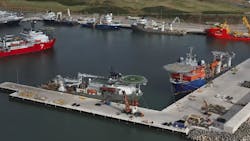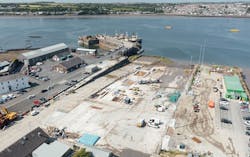UK ports making preparations for floating offshore wind
Editor's note: A condensed version of this story first appeared in the 2023 Offshore Wind Special Report, which published within the September/October 2023 issue of Offshore magazine.
By Jeremy Beckman, London Editor
Ports will play a major supporting role in the commercialization of floating offshore wind (FLOW). Britain’s seas could become a test case for the industry, with various developers aiming to start construction over the next few years of floating wind parks in the North Sea, in areas provisionally awarded under the recent Scotwind and Innovation and Targeted Oil & Gas (INTOG) lease rounds. But the building blocks will need to be put in place before the 26 potential projects can go forward, allowing the UK government to reach its targets of 5 GW of FLOW by 2030 and 34 GW by 2040.
A report commissioned by the Floating Offshore Wind Taskforce called for urgent conversion of up to 11 ports around the UK to industrial hubs to meet the sector’s future needs at a collective cost of about £4 billion ($4.99 billion). A minimum of three to five ports will be needed, the report advised, to install wind turbines onto floating substructures and a further two to service future FLOW projects in the Celtic Sea offshore west Wales and southwest England. Industry association RenewableUK, a member of the taskforce, commissioned RoyalHaskoningDHV to compile the “Industry RoadMap 2040: Building UK Port Infrastructure to Unlock the Floating Wind Opportunity” report. The first-phase report, delivered early this year, identified key infrastructure needs for various deployment scenarios. It also determined the primary government and industry assistance mechanisms for the FLOW supply chain, such as the FLOW manufacturing investment scheme (FLOWMIS).
Ports are integral to the FLOW supply chain as they serve as an interface between land-based and marine activities. Manufacture of the turbine components, cables, mooring systems, substations and substructures will take place either in the UK, nearby countries or further afield. But assembly and integration will require appropriate infrastructure closer to the projects at ports, including storage, load-out, outfitting and wet-store facilities. Ports could also host new FLOW manufacturing centers and support operations and maintenance through accommodating a fleet of specialist offshore wind vessels and providing access for the tow-in of structures and lay-down areas.
Other requirements identified by the report authors are large land areas, reinforced quays and deepsea harbors. And ports will need to consider the numbers, types and sizes of the turbines and foundations likely to be installed for scaled-up projects, as well as ensure access for larger substructures and support vessels. Port capacities and capabilities—maximum weights, dimensions, draft and quayside space—could in certain cases limit the technical feasibility of handling larger turbines. As for steel assembly and concrete manufacture, it should be possible to convert areas set aside at ports for either operation, depending on which type of material becomes more prevalent for FLOW developments. Concrete manufacturing would entail higher bearing capacities in quayside areas to cope with the heavier substructures (about 20,000 t). Another consideration for concrete is how to move substructures to quayside to prevent production bottlenecks. Steel substructures for FLOW appear to be typically about 4,000 t and can be transported using self-propelled modular transporters.
The increased water depths farther out at sea for FLOW projects may rule out offshore assembly. A combination of gantry, tower, mobile and crawler cranes will probably be needed at ports to integrate turbines onto floating foundations in water directly alongside the quay. But the large dimensions of the anticipated turbine sizes will be demanding in terms of lifting capacity, hook heights and air draft. For 20-MW turbine nacelles, the weights could approach 1,000 t with hub heights of more than 150 m, beyond the capacity of the largest crawler cranes at present. The hub height at which nacelles have to be installed is also a limiting factor for both onshore cranes and current floating crane vessels. While jackup vessels or semisub cranes inshore might be deployed for turbine assembly, there could be logistics issues due to the constraint of having both a floating vessel and the FLOW structure berthed at the quay edge.
With substructures most likely to be constructed at ground level rather than in a dry dock, ports will need to design facilities for launching from quaysides into the sea. For concrete substructures, the various options aside from conventional slipways or launch ways could include slipways with marine railways/launching cradles, jackup barges or floating load-out barges, and floating docks. Finally, the installation vessels that will be receiving the turbines and taking them to their offshore mooring points will need access to sufficiently deep channels and berths and sufficient quay space.
UK ports have shown strong interest in the government’s FLOWMIS financial support mechanism, which offers funding for investments in port and manufacturing developments that scale up deployment to meet the government’s FLOW ambitions. The government and regional administrations could also support a collaboration between FLOW developers and port owners, the report suggested, allowing the industry to develop and potentially share port infrastructure facilities.
According to Laurie Heyworth, senior policy analyst with RenewableUK, “FLOWMIS is a first step in de-risking the first tranche of port infrastructure upgrades needed to successfully inaugurate the floating wind sector. Floating offshore wind is an emerging technology that will form a huge part of the UK’s future offshore wind portfolio. It can operate farther out at sea than fixed offshore wind, in water depths beyond 50 m, in areas where the wind speeds are higher, with potential to deliver more megawatts of power through larger turbines that are mounted on top of floating substructures. For all the myriad of floating concepts out there, there are basically four technology groupings: barge, semisub, TLP and spar. For ports, the main issue is whether they can accommodate the in-time assembly, integration and manufacturing activities required for mass deployment of these colossal structures.
“Floating offshore wind developers will be talking to ports in the UK, trying to secure rent-out space and create partnerships to ensure they’re ready in time to go ahead with their projects. Ports often feel they are the last to be consulted in the value chain, but there is now within the industry a sense of urgency, a need for collaboration with ports to do dredging, create laydown space, get cranes and vessels in place, and so on. The lead times for construction are huge; ports can take five years to implement major infrastructure upgrades, which then have to be followed by a preparatory operations phase.
“Time is therefore of the essence, as investment must start without delay to support the anticipated mass rollout of UK-based floating offshore wind projects by the end of this decade. To justify this investment, however, port operators require certainty of a sustainable, predictable project pipeline, not just a single tenant that may pay to use the site for a couple of years during the development and construction phase. They need revenue stability and guarantees of the continued use of their facilities by multiple developers over an extended period.”
The road map report identified numerous port and harbor facilities in Scotland that could adapt to support the ScotWind FLOW projects. Both the Shetland and Orkney Islands have deepwater facilities for exporting oil and gas. Cromarty Firth Port at Invergordon in the northeast is already providing staging and marshalling services for fixed-bottom offshore wind farms and also has an agreement to cooperate with BW Ideol, developer of the Damping Pool concept for FLOW turbines, to establish a concrete hull manufacturing yard. Aberdeen and Peterhead are also major hubs for offshore supply and logistics. When FLOW developments eventually extend to the Celtic Sea offshore west Wales and southwest England, three ports in the region could potentially be developed to provide industrialized integration facilities. Bearing in mind the lead times on assembly, the ports would need to be ready to start accepting components and begin fabrication in 2028-29 to ensure FLOW deployment rates are achieved.
Port of Aberdeen
In August 2023, Port of Aberdeen completed its £420 million Aberdeen South Harbour expansion, which started in 2017. This provides 1,500 m of deepwater berths (from 9 m to 15 m), cranage at quaysides purpose-built for heavy-lift capabilities, 125,000 sq m of laydown space, and ample areas to receive vessels up to 300 m long. According to Kieran Morton, business development manager at the Port, targeted markets include provision of integration and marshalling services for FLOW solutions.
“While floating offshore wind structures for North Sea projects can be built in the Far East, Middle East or closer in Europe, there is still the need for marshalling and integration at a nearby port—lifting nacelles on top of towers, fitting blades, and so on," Morton said. “Port of Aberdeen now offers the largest berthage in Scotland and within 200 km of 75% of all Scotland’s existing and future wind farms, so it is very well geographically placed. It also brings 50 years’ experience in vessel logistics for offshore oil and gas, with, 7,000 vessels coming in and out of the port each year, and services for long-term maintenance.
“If you look at the figures for the number of turbines that need to be assembled within the next 15 years, the space and investment required is phenomenal. Facilities will need to be in place at ports at least 18 months before a project using them is ready to start. We are in discussions with all the INTOG developers; the location of ports is very important to them, and we expect the ones closest to us to have the largest requirements. The support they are looking for depends on their choice of substructure, the manufacturing process on their requirements for infrastructure, substructures, turbines and so on. Some of the smaller INTOG projects could be completed over the next five to eight years, but the larger projects won’t be ready to start until 2030-31. You have to bear in mind that there is a seven- to eight-year waiting list for offshore wind developments just to be connected to the UK grid. Some of the projects supposed to start in 2027-28 will have to choose ports in next 12 months in order to be in a position to award contracts.
“We are aware of over 100 different designs of FLOW structures; we have the capability to support some of these. For some of the bigger concrete structures, the depth required for float-out is incredible. Dredging is a major issue, and the investment costs for accommodating larger structures for a project would probably be borne by the developer, although we have already applied for private funding for this purpose.”
Developers talking to ports
INTOG is a leasing round for offshore wind projects designed to reduce emissions from oil and gas production centers in the UK North Sea. Various companies awarded leases in May for 13 of the larger (TOG) projects involving FLOW technology and were expected to sign their exclusivity agreements this year.
There are no approved floating or fixed offshore wind developments in the Celtic Sea, but ports in Wales are preparing for the future scenarios. One example is the £60 million ($74.6 million) Pembroke Dock Marine project, a partnership between the Port of Milford Haven, Offshore Renewable Energy Catapult, Marine Energy Wales and Celtic Sea Power, with funding provided by the UK and Welsh governments. A slipway is being widened to 68 m and extended to 11,352 sq m to provide greater flexibility for potential developers and to supply chain companies that would offer maintenance and engineering services to local FLOW developments. New workboat pontoons are being installed east of the existing ferry terminal offering short- and long-term berthing options for workboats, barges and jackup barges.
Associated British Ports is looking to develop a FLOW center of excellence in the Celtic Sea served by ports in south Wales. The Port of Port Talbot has the required deepwater access and brownfield land ready for development. Its main user, Tata Steel, has formed a partnership with power utility RWE to investigate production of steel components that could be used in floating wind foundations and structures for FLOW projects in the Celtic Sea. RWE is proposing a series of gigawatt-scale floating wind developments for a future lease round Crown Estate plans in the region. If successful, the projects would form part of RWE’s decarbonization hub, Pembroke Net Zero Centre.
About the Author
Jeremy Beckman
Editor, Europe
Jeremy Beckman has been Editor Europe, Offshore since 1992. Prior to joining Offshore he was a freelance journalist for eight years, working for a variety of electronics, computing and scientific journals in the UK. He regularly writes news columns on trends and events both in the NW Europe offshore region and globally. He also writes features on developments and technology in exploration and production.




